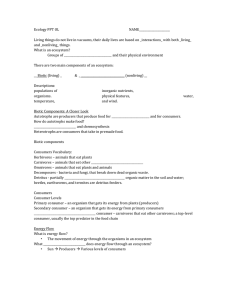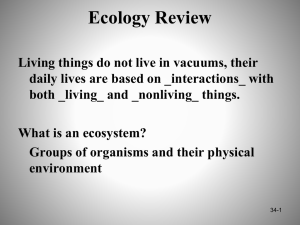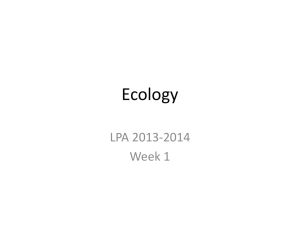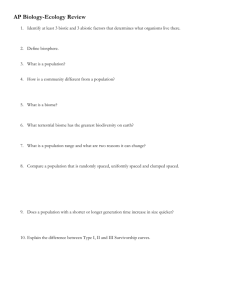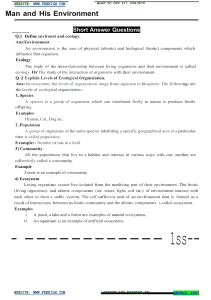Ecology Review
advertisement
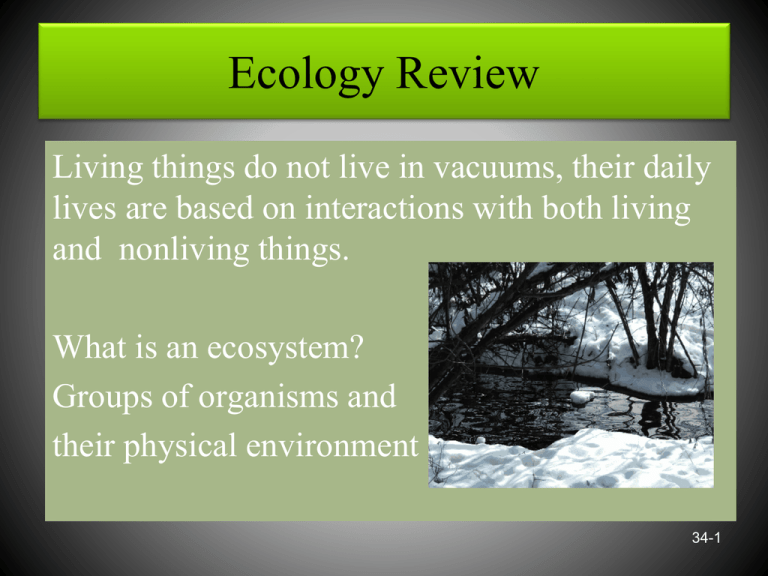
Ecology Review Living things do not live in vacuums, their daily lives are based on interactions with both living and nonliving things. What is an ecosystem? Groups of organisms and their physical environment 34-1 There Are Two Main Components Of An Ecosystem: Biotic -Living Populations of organisms. temperature, & Abiotic-Nonliving Inorganic nutrients, physical features water, and wind. 34-2 Biotic Components: A Closer Look Autotrophs are producers that produce food for themselves and for consumers. How do autotrophs make food? Photosynthesis and chemosynthesis Heterotrophs are consumers that take in premade food. 34-3 Biotic Components 34-4 Consumers Vocabulary: Herbivores – animals that eat plants Carnivores – animals that eat other animals Omnivores – animals that eat plants and animals Decomposers - bacteria and fungi, that break down dead organic waste. Detritus - partially decomposed organic matter in the soil and water; beetles, earthworms, and termites are detritus feeders. 34-5 Consumers 34-6 Consumer Levels Primary consumer – an organism that gets its energy from plants (producers) Secondary consumer – an organism that gets its energy from primary consumers Tertiary consumer – carnivores that eat other carnivores; a top-level consumer, usually the top predator in the food chain 34-7 Energy Flow What is energy flow? The movement of energy through the organisms in an ecosystem What direction does energy flow through an ecosystem? Sun Producers Various levels of consumers 34-8 Energy Flow As energy flows from autotrophs (producers) to heterotrophs (consumers) much of the energy is lost before the consumer can use it. In what forms is energy lost? Heat Initial energy from an ecosystem comes from a consistent supply of solar energy Remember energy in an ecosystem may be transferred or converted but will not be created nor destroyed 34-9 Energy Balances 34-10 Energy Flow in an Ecosystem 34-11 Food Chains vs. Food Webs What is a food chain? A diagram that links organisms together by who eats whom Starts with plant life and ends with an animal. Most food chains have no more than 4 or 5 links Arrows show the direction energy is flowing EXAMPLE: grass zebra lion 34-12 Food chain 34-13 FOOD WEB Most consumers feed on and are eaten by more than one other consumer What is a food web? A combination of several food chains showing all of the possible energy pathways What is a trophic level? All of the organisms that feed at a particular link of the food chain/web 34-14 Food Webs Grazing food web – The upper portion of a food web based on a living plant as the producer Detrital food web – The lower portion of a food web based on detritus 34-15 Forest Food Webs 34-16 Ecological Pyramids Why are food chains so short? Only about 10% of energy is useable from one trophic level to the next The number organisms drastically decreases as you go up in level of a food chain What is an ecological pyramid? A series of blocks representing the biomass of particular organisms on a particular trophic level What is biomass? The amount of living material in the population of an organism 34-17 Ecological Pyramid 34-18 Biochemical cycles What are biochemical cycles? The path by which important nutrients/molecules travel through an ecosystem. 3 Important Cycles: Water Cycle Carbon Cycle Nitrogen Cycle 34-19 The Water Cycle Water movement: Land Atmosphere: Liquid Gas Evaporation from rivers, lakes and oceans Transpiration from plants Atmosphere Land Gas Liquid Precipitation over land and bodies of water Runoff forms bodies of water (lakes, rivers, oceans) Ground water seepage into aquifers 34-20 The Water Cycle 34-21 The Carbon Cycle Carbon Movement: Land/Water Atmosphere Respiration Combustion Atmosphere Land/Water Photosynthesis Dissolved CO2 ** Carbon is stored as fossil fuels from decaying organisms.** 34-22 The Carbon Cycle 34-23 The Nitrogen Cycle Nitrogen Movement: Nitrogen Fixation Bacteria found in legume roots converts N2 gas into Ammonia (NH4) Decomposers break down waste and organic remains into Ammonia (NH4) Nitrification bacteria convert ammonia into Nitrite (NO2) and Nitrate (NO3) to be used by plants Denitrification Bacteria converts ammonia back into Nitrogen gas (N2) 34-24 The Nitrogen Cycle 34-26
